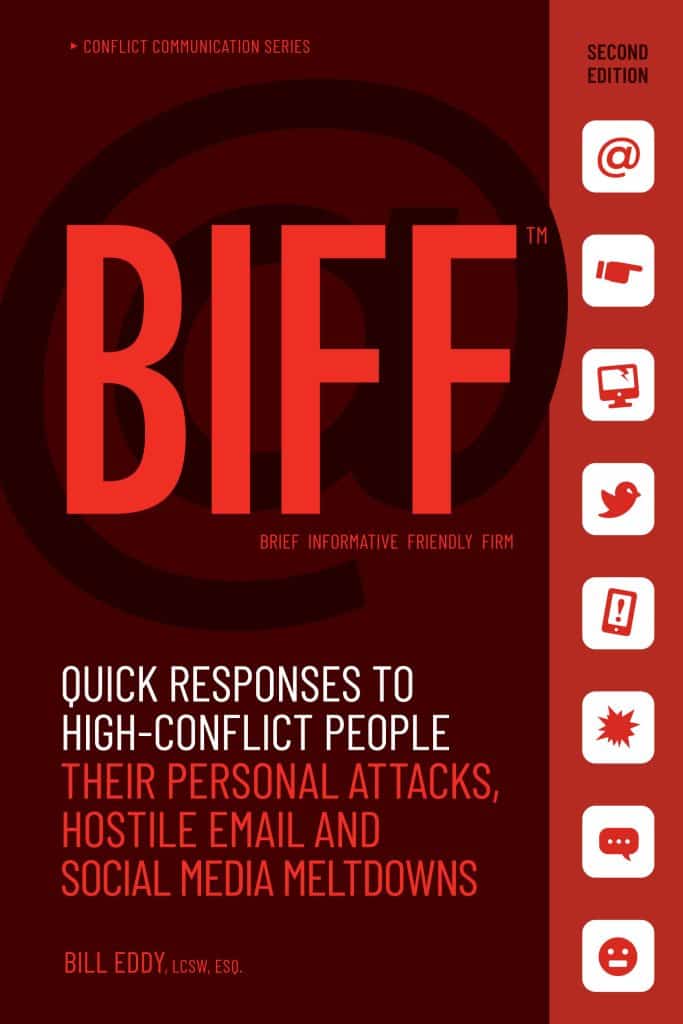How to Reply to Angry Texts & Emails – 5 BIFF Response® Examples

©2017 Bill Eddy, LCSW, Esq. Dealing with High Conflict People and their irate communications can leave you at a loss for words. The BIFF Response® Method helps you get your thoughts organized and under control so you can respond effectively. To be most effective, we suggest you explore the method in the BIFF Response® book to give you the method essentials. Then we tell people to practice, practice, practice! When you want to utilize The BIFF Response® method, you may find yourself staring at a blank screen wondering, “What do I say?” The answer will vary from case-to-case, but let’s review the ground rules and then go over a few examples. Rule #1 is always to ask: “Do I need to reply to this at all?” Pause. Take a deep breath. Then read the email/ text with a critical eye: Is there anything that really requires a reply? (A deadline, an appointment, a PTA conference, a needed decision). Look for valid matters and ignore the barbs. A decision on an appointment time is valid. An accusation that you never communicate is invalid. Asking what time to pick up a child is valid. Saying everybody is mad at you/blaming you is not valid. Additionally, a decision needed for a concrete issue is only valid if it’s new. Further demands to discuss the same matter are not valid and need no reply, or a shorter version- one time – of what you said last time. Don’t take the bait when the next re-worded email with the same demand comes along. If you need to reply, then follow BIFF: Brief: Keep it brief. Long explanations and arguments trigger upsets for HCPs. Informative: Focus on straight information, not arguments, opinions, emotions or defending yourself (you don’t need to) Friendly: Have a friendly greeting (such as “Thanks for responding to my request”); close with a friendly comment (such as “Have a good weekend”). Firm: Have your response end the conversation. Or give two choices on an issue and ask for a reply by a certain date. Leave out the 3 A’s An entire chapter is dedicated to this in the BIFF books, but the highlights of what to avoid are: Advice. Are you telling the other person what to do, how to behave, or how to feel? If so, you can expect a defensive reaction and more email/texts. It’s better to avoid unsolicited advice such as “You just need to do X.” Make a proposal instead. Admonishments. Telling a defensive or upset person what they do wrong and how to fix it will just make them more defensive and earn you another accusatory reply. Things like “You’re overreacting” or “You should be ashamed” are not going to help them hear you. Apologies. Most of us apologize sometimes, but it easily backfires with HCPs. “Sorry I was late” is OK as a social nicety. “I’m sorry my email upset you” is accepting responsibility for the other person’s emotions. It’s almost guaranteed to be taken as an admission of guilt, which an HCP will use against you to place blame and defend their actions. A Family Member Example: Bob’s email: “Thanks for nothing. My boss threatened to fire me today. Some sister you are! I TOLD YOU I COULDN’T BE LATE AGAIN. You know I’ve been meaning to get the car checked. I can’t control when it breaks down. BUT YOU COULDN’T BE BOTHERED WITH HELPING ME GET THERE, COULD YOU???? You and your FANCY JOB. You don’t have to worry about unreasonable bosses. You could have taken time off to help YOUR OWN BROTHER!!! Mom’s mad at you too. I hope you’re happy!” Sue’s Response: “Hi Bob, I’m glad you were able to make it and that you still have your job. As I said this morning, I couldn’t miss my meeting. I can make time to help you drop off your car for repairs on Saturday or Tuesday. Let me know by 11:00 tomorrow what day and time you need to go since I must give advance notice to my work. If I don’t hear by then, I’ll just assume you won’t need my help with it. Have fun at the baseball game tonight. –Sue.” A Divorce Example: Text from the Ex: “I got a new lawyer today. Boy, are you in trouble. All the BS you say about me is going to get you hammered in court. You’ll NEVER get any custody because you’re such a sack of s**t and you’re going to have to give me a ton of money. Lots more than that crappy amount you pay now. I hate you and now you’ll be sorry you filed for divorce.” Your reply: Nothing. Sometimes the hardest part of a BIFF Response is not doing it at all. Choose to ignore this and you’ll avoid spending the next few hours battling it out. A Co-Parenting Example: Text from Mom: “Thanks for nothing you pile of crap. Those clothes you bought for his birthday are junk. I’ll be asking the judge for more money so I can get him something decent to wear when he does things like go to his doctor appointment on Thursday. Drop dead.” Dad says: “Thanks for letting me know about his doctor appointment. I’ll check in after to hear what the doc said.” A workplace Example: Team member email: “Who do you think you are? You’re messing up the whole project and making me look bad!!!! You know we were supposed to turn in the figures yesterday, but noooo. You’re so important you thought you could get away with a TWO-HOUR BREAK. I couldn’t get it done and it’s YOUR fault! You need to get your s**t together, EVERYONE thinks so!!!” You: “Hi Coworker A, I appreciate your concern for getting reports in on time. As I mentioned in my email to everyone last week, my meeting could not be rescheduled. I’ve attached a copy of the email for you. You’ll see that Ms. Boss gave us an extension
4 Ways to Set Limits at Work

Whether you’re dealing with a difficult employee, co-worker or supervisor, setting limits is one of the most difficult and important tasks you can do to get any real work done.
How to Spot & Avoid the Worst Times to Engage with a Difficult Person

©2012 Bill Eddy, LCSW, Esq. We all have dealings with high conflict people, in our families, at work and in our communities. They often catch us by surprise with their extreme thinking, emotions and behavior, which can include: an inability to compromise, lying, spreading rumors, stealing, damaging property, hiding money, suing their employers, frivolous lawsuits, stalking, abusing children, alienating children, domestic violence and sometimes even killing people. Yet most people scratch their heads, wondering why – and how to prevent these extreme behaviors in the future. Generally, HCPs have a narrower range of behavior than ordinary people, which makes them more predictable. Understanding the patterns of their behavior can help you predict times of high risk – and to calm them or protect yourself before they escalate into their extreme behavior. This article explains some of the issues involved in predicting and avoiding their worst high-conflict behavior. High Conflict People (HCPs) High conflict people (HCPs) have a pattern of getting stuck in conflict and increasing conflict, rather than reducing or resolving conflict. They tend to repeat and repeat their pattern, somewhat regardless of the circumstances and consequences. This pattern usually includes the following, which is often obvious to others, but not to themselves: A preoccupation with blaming others All-or-nothing solutions Unmanaged emotions Extreme behaviors They lack awareness of this pattern and their negative impact on others, so that giving them negative feedback tends to increase their negative behavior (including intensely blaming the person who gave them the feedback) rather than leading to insight. For this reason, it’s important NOT to tell someone that you think he or she is a high-conflict person. (For methods of handling them that don’t rely on negative feedback, see the book: It’s All Your Fault: 12 Tips for Managing People Who Blame Others for Everything, Eddy.) HCPs tend to get stuck in this pattern and regularly engage in their extreme behavior when things don’t go well for them – especially in their high-expectation relationships. High-Expectation Relationships (HER) HCPs tend to play out this high-conflict pattern in high-expectation relationships, such as a boyfriend or girlfriend, husband or wife, parent or child, close co-worker, best friend, professional involved in intense problems (such as a lawyer, therapist, doctor, clergy) and/or with people in positions of authority (such as a boss, employer, government agency representative). In other words, it’s a relationship pattern – much like the relationship a child has with a parent: expectations of being taken care of; being really secure in the relationship; getting lots of attention and respect; tolerance of any behavior; and so forth. However, when there is a threat to this high-expectation relationship, HCPs tend to engage in intense behavior to maintain the relationship or punish the person for its loss – much like the way a young child treats a parent when desperately clinging or having a temper tantrum. For HCPs who grew up with “insecure attachments” in their early childhood relationships with their parents, it may be that they are seeking a “secure parent-child attachment” in their adult relationships. Of course a secure parent-child attachment can never be completely fulfilled in an adult relationship, because adults cannot have the “unconditional love” for each other that a parent must have for a small infant (such as paying lots of one-way attention or tolerating lots of temper tantrums). So when HCPs engage in high-expectation relationships, they are bound to be frustrated when the reasonable person (or another HCP) can no longer tolerate their extreme (essentially child-like) behaviors. Yet the occurrence of these extreme behaviors can be predicted, to some extent, by understanding what triggers them. Times of High Risk For HCPs, extreme behavior is triggered by the perceived loss of the high-expectation relationship and their over-reaction to it. For an HCP, this sense of loss is carried inside and can burst out in any high-expectation relationship regardless of what the other person does, but especially at times the HCP perceives a relationship loss. In the workplace or at school: For example, people experiencing bullying at work or at school often question themselves about what they did to cause the bully (often an HCP) to treat them so badly. Yet, much of the time it may be the HCP’s own thinking that has triggered an internal upset that then triggered their high-conflict behavior. However, there are events and warning signs that can help in knowing when there are times of high risk in the workplace or at school. In cases of domestic violence, the victim often wonders what they did to cause their loved one to strike out at them. They often hope it was a mistake and won’t happen again. Then, when it happens again and again, victims lose self-esteem because they often blame themselves and lose energy and become more isolated. This, of course, is reinforced by the perpetrator of the domestic violence. The most important message here is that it is not about the victim or “target of blame,” but rather about the bully or the perpetrator of domestic violence, and his or her perception of relationship loss that triggers their own extreme behavior in an effort to protect himself or herself against this perceived loss. At first, it may be a mistaken assessment of danger on the part of the HCP. But then, their extreme behavior often leads to a real loss, as the victim or target of blame truly does try to get out of the relationship with the HCP. Such times are times of high risk, but times of any type of loss of relationship security are times of high risk with an HCP. Types of loss by personality type: There appears to be at least five types of high-conflict people who engage in extreme behavior related to perceived relationship loss. Each type seems to have a particular relationship fear and over-reaction when it is triggered – either by internal upsets (such thinking about their own fears) or external events (such as a partner trying to leave the relationship or an employer threatening termination).
